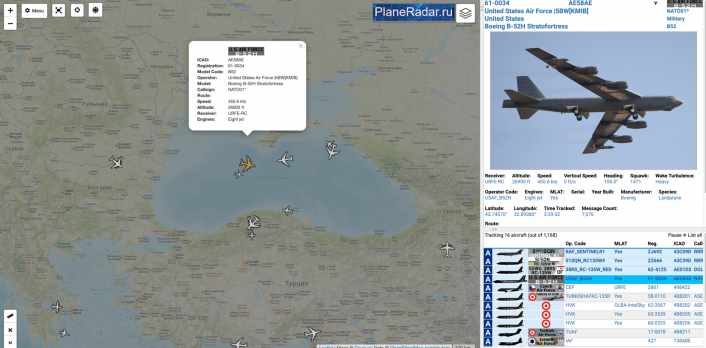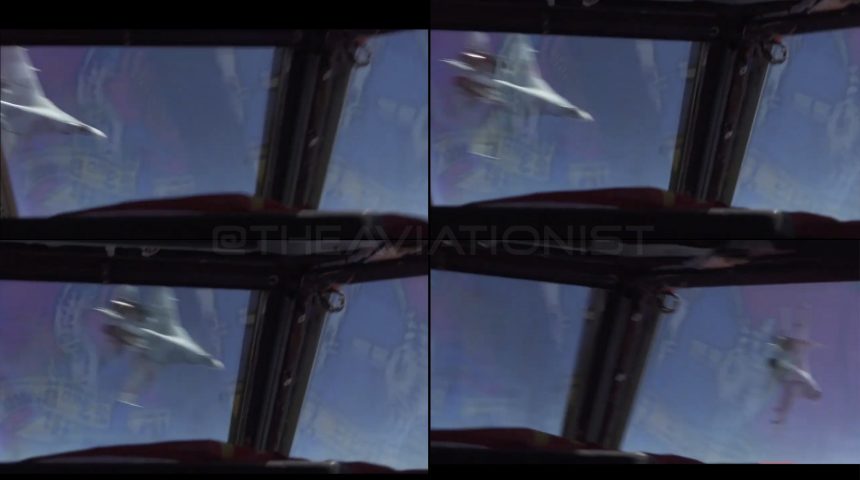The footage shows from the cockpit of the B-52 what the U.S. DoD deemed an “unsafe and unprofessional intercept” by the Russians.
As we have already reported with plenty of details, on Aug. 28, 2020, six U.S. Air Force B-52 Stratofortress strategic bombers participated in Allied Sky, a single-day mission that saw the BUFFs overflying all 30 NATO nations.
In particular, one of the B-52s of the 5th Bomb Wing from Minot Air Force Base, North Dakota, currently deployed to RAF Fairford, UK, as part of Bomber Task Force 20-4, using the radio callsign “NATO 01” and keeping its Mode-S transponder on, undertook an interesting tour flying from RAF Fairford across Eastern Europe to the Black Sea area and then back via (among the others) Turkey, Greece, Croatia, Slovenia, Italy and France.
During its 12-hour tour, NATO01/61-0034 was escorted by JAS 39 Gripen over the Czech Republic; by F-16s and MiG-21 Lancers over Romania; MiG-29s over Bulgaria; MiG-21s over Croatia; F-16s over Greece; Italian Air Force Typhoons and F-35s intercepted and escorted NATO 01 over Italy. As explained in the previous article, when over the Black Sea, off Crimea, the B-52 was also escorted by two Russian Air Force Su-27 Flankers that, according to the Pentagon, carried out an unsafe and unprofessional intercept on the U.S. bomber. We linked the press release in yesterday article but let’s have a look at in more in detail here:
At approximately 11:19 a.m. on Aug. 28, 2020, two Russian Su-27 Flanker pilots intercepted a U.S. Air Force B-52 bomber that was conducting routine operations in the black sea over international waters. The Russian pilots flew in an unsafe and unprofessional manner while crossing within 100 feet of the nose of the B-52 multiple times at co-altitude and while in afterburner causing turbulence and restricting the B-52’s ability to maneuver.
“Actions like these increase the potential for midair collisions, are unnecessary, and inconsistent with good airmanship and international flight rules,” said Gen. Jeff Harrigian, U.S. Air Forces in Europe-Air Forces Africa commander. “While the Russian aircraft were operating in international airspace, they jeopardized the safety of flight of the aircraft involved. We expect them to operate within international standards set to ensure safety and prevent accidents,” he added.
Our B-52 Stratofortress aircraft was conducting routine operations in international airspace exercising our freedom of navigation and overflight. The U.S. Air Force routinely operates aircraft in the region in accordance with recognized international safety standards as prescribed in International Civil Aviation Organization (ICAO) rules of flight.
We don’t know where the intercept took place. However, we have an idea of the route the aircraft flew thanks to Planeradar.ru:

It’s not the first time and it won’t probably be the last one the Russian intercept is deemed “unprofessional” and “unsafe”. We have reported about several such incidents, most of time involving U.S. Navy P-8A Maritime Patrol and Reconnaissance Aircraft in the Black Sea or off Syria, when Russian and also Chinese fighters allegedly performed Top Gun-like stunts close to a U.S. aircraft. However, in most such cases just footage filmed by the onboard camera is released and we have never really seen interceptors aggressively maneuvering in front of the U.S. aircraft. Quite the contrary, the footage usually released only shows the interceptors closing on the wings of their target, without doing anything really dangerous, so much a former RC-135 aircraft commander who flew the S, U, V, W, and X models, commenting the intercepts, once told us “what passes for dangerous and provocative today was ho-hum to recon crews of my generation (although we weren’t shot at like the early fliers from 1950-1960).” Moreover, back in the days, some “stunts” were performed at the request of the intercepted aircraft.
This time, it’s different. The Pentagon has released a clip, possibly filmed with a smartphone, of the Russian Su-27 crossing extremely close to the nose of the B-52. That’s, by all standards, dangerous and unprofessional. Take a look by yourself (if you can’t see the video in the tweet below click here):
US military releases video of what it says was an “unsafe and unprofessional” intercept by Russian Su-27 jets of a B-52 bomber while it was flying over the Black Sea yesterday. The US said the Russian jets crossed within 100ft of the B-52 while in afterburner causing turbulence pic.twitter.com/h5MxCtVK6w
— Ryan Browne (@rabrowne75) August 30, 2020
Thus far, these stunts have never caused real damage but we should not forget some incidents of the past.
On Apr. 1, 2001, a U.S. Navy EP-3E with the VQ-1, flying an ELINT (Electronic Intelligence) mission in international airspace 64 miles southeast of the island of Hainan was intercepted by two PLAN (People’s Liberation Army Navy) J-8 fighters. One of the J-8s piloted by Lt. Cdr. Wang Wei, made two close passes to the EP-3 before colliding with the spyplane on the third pass. As a consequence, the J-8 broke into two pieces and crashed into the sea causing the death of the pilot, whereas the EP-3, severely damaged, performed an unauthorized landing at China’s Lingshui airfield. The 24 crew members (21 men and three women), that destroyed all (or at least most of ) the sensitive items and data on board the aircraft, were detained by Chinese authorities until Apr. 11, 2001.
On Sept. 13, 1987, a RNoAF P-3B had a mid air collision with a Soviet Sukhoi Su-27 Flanker over the Barents Sea. While maneuvering below the P-3B, the Su-27P collided with the outboard right propeller of the Orion: the impact shattered a fin tip of the Su-27P and caused fragments of the propeller to puncture the P-3B’s fuselage, causing a decompression. The Orion experienced severe vibrations and the outboard right engine was shut down. Both aircraft were able to return safely to their bases.
Now, considered all the tensions of this Cold War 2.0 era, imagine the reactions would a Russian fighter collide mid-air with a U.S. strategic bomber..









